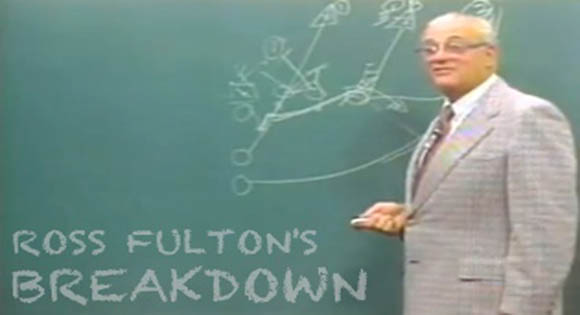As with the offense, Luke Fickell and Everett Withers' defensive coaching staff must fit their defensive schemes with their personnel. Several schemes will be particularly important for the 2013 Buckeyes, as the staff will look to implement coverages to take advantage of Bradley Roby and the veteran safeties, along with mixing it up to create confusion for offensive lines facing a young, but talented Buckeye front.
I don't need a gun I've got a Donk
Facing primarily spread offenses, the Buckeye defense will rarely play their "base" 4-3 under, instead preferring nickel. But when Ohio State does face pro-style 21 personnel (2 WR, 2 RB, 1 TE) expect to see ample amounts of quarter-quarter-half coverage.
As the name indicates, one half of the defensive backfield will play quarters or cover 4 coverage, while the other half plays cover 2.

The Buckeyes do this for one reason, namely Bradley Roby. The Ohio State coaching staff prefers to align their defensive strength to the wide side of the field. Doing so allows the defense to have greater numbers to cover open grass and easily adjust to motions and shifts.
Offenses sought to exploit that last fall, however, by running to the boundary. Enter quarter-quarter-half. Cover 2 is played to the boundary, while the boundary cornerback (Roby) is put in press coverage on the line of scrimmage. From this position, Roby is the defense's force player.
He is such a physical corner that he can maintain outside leverage and attack downhill, limiting an offense's ability to run boundary-side. The coverage provides the added bonus of letting Roby take away the underneath half of an opposing team's boundary passing game, allowing the Buckeye defense to roll its coverage to the field.
Expect the Ohio State defense to often feature quarter-quarter-half against 21 personnel in first or second down. The other look the Buckeyes will feature in those circumstances is cover 1 man-coverage robber.
Match it up
In first and second down against spread offenses, meanwhile, the Buckeyes will often play cover 4. In cover 4, every defensive back is responsible for one quarter of the field.

What looks like soft zone coverage is actually an aggressive scheme. Cover 4 utilizes zone pattern matching. This is the equivalent of matchup zone in basketball. Each pass defender will play man-to-man against a receiver within their zone. The difference with man coverage is that when a receiver leaves a defender's zone the defensive back or linebacker passes the receiver to their teammate, anticipating that another receiver is coming to their area. The key to this scheme is thus research and recognition. Defenders are taught pass patterns combinations to anticipate how the patterns will distribute throughout the coverage.
Cover 4 allows a defense to aggressively attack the run game. A limitation of true man coverage is that pass defenders must turn their back and follow receivers. Cover 4's pattern matching avoids this shortcoming. Cover 4 safeties watch the inside or number 2 receivers. If these receivers block, the safeties will come downhill to play run.

This is why the Buckeye defensive coaches like using cover 4 versus spread teams. The defense has sufficient defensive backs to defend deep in case an offense runs four vertical pass routes. At the same time a defense can quickly apply nine defenders against the run game.
Cover 4's benefit is therefore its versatility to combat the variety offered by modern offenses.
Bring It
The Ohio State defense's goal is put the offense in third and long. In that situation the offense is one-dimensional and the defense has options.
To exploit those options the Buckeye defense often operates from an odd 30 front look. The coaching staff goes small, moving a defensive end to nose guard and bringing in two pass rushers at end. The defense has a stand-up viper, two linebackers and a star.

This front's purpose is confusion. The defense can drop in an eight man zone coverage. But the defense can also employ a variety of zone blitzes. One Buckeye coaching staff favorite is the X zone blitz. The two inside linebackers cross and blitz the opposite A gap. The viper drops into coverage. This provides the defense five rushers and six pass defenders. The defense can therefore play a relatively safe cover 3 while simultaneously seeking to overload an offense's pass protection.
The Buckeye defense struggled last year while the coaching staff gained their play calling rhythm. The unit turned the corner once the staff embraced a single philosophy. Seek to use coverage schemes to support stopping the run in first and second down and then provide variety of looks in third and long to confuse opposing quarterbacks. This is the strategy the Buckeyes will likely double down on in 2013.



